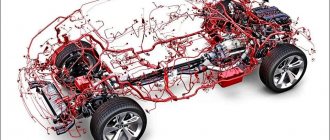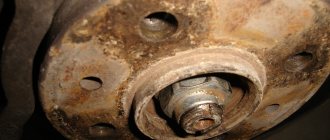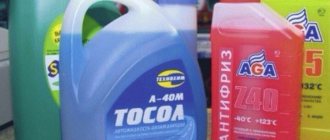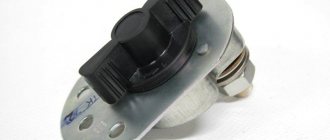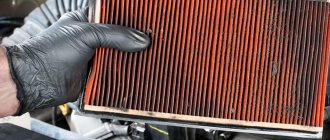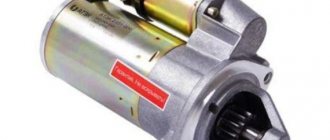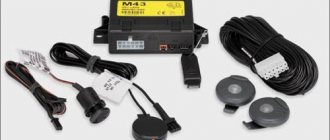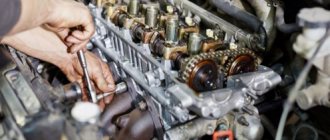Restore battery quite possible with your own hands at home. A fully serviceable and well-charged battery is the key to reliable operation of any self-propelled vehicle (passenger car, in particular). However, when operating a car, there are often situations when the on-board device is heavily discharged. Under certain conditions, the battery does not take charge from the charger at all and does not “hold” the operating voltage.
Low battery
The information provided in this article will help you understand the reasons for the deep discharge of modern batteries, as well as the possibilities for their restoration. After familiarizing yourself with it, everyone can try to independently repair a car battery after a deep discharge.
What batteries can be restored?
Before you restore your car battery, you should know that this procedure does not help in all cases. It is possible to “revive” a car battery only in the situations listed below:
- when during operation its plates are not destroyed by high current loads and there are no closed cans in the battery;
- if they have not received irreparable mechanical damage;
- when the battery has become unusable due to natural sulfation.
Restoring a battery is considered an almost impossible task if its plates are severely damaged.
Another option for a critical battery malfunction is when the cans are shorted, swollen, or other mechanical damage is detected.
In all other cases, restoration of the product is possible, but only subject to strict adherence to time-tested technologies.
Sulfation of plates and network rupture
This is one of the most common battery breakdowns, which you can deal with yourself. The reasons for this malfunction include:
- long-term battery storage without recharging;
- reducing the volume of electrolyte composition in battery banks;
- the use of too dense electrolyte;
- using a vehicle with an overly discharged battery.
The surest symptom of plate sulfation is the appearance of crystals of lead sulfate on them.
This substance does not dissolve in the electrolyte, and when accumulated on the plates, it prevents the passage of liquid to the active mass. As a result, the battery capacity is significantly reduced. The device can be saved if the process has not yet seriously destroyed the plates. If they are almost completely covered with crystals, then it will be cheaper to completely replace the battery.
A break in the internal network is often observed in older models. One way or another, this problem can be solved very cheaply and simply. To solve the problem, you just need to adjust the plates.
Why is deep discharge undesirable and dangerous?
Battery discharge is a natural phenomenon, since it is designed for this purpose. Its main task is to gradually accumulate energy and then release it into the payload. This process is repeated cyclically until the product has exhausted its service life. But until this time, it is able to restore its charge many times.
When considering the safety of lead acid batteries, it is important to consider the following points:
- the design of modern batteries, although carefully thought out, is still far from perfect;
- like any element that accumulates energy, they have problem areas;
- these products do not “tolerate” excessive charging well, leading to rapid destruction of the plates in the banks;
- Deep discharge of batteries has a particularly negative effect on them.
Deep battery discharge leads to the following undesirable consequences:
Large insoluble crystals form inside the battery
the electrolyte becomes depleted, becomes weaker and is not able to create the required energy capacity
the formation of an insoluble precipitate on the plates makes it difficult for current to pass through, and the resistance increases
In order not to bring the battery to a critical state of discharge, a whole system of measures is provided, including monitoring the density of the electrolyte in the banks and maintaining its normal level.
Self-discharge and oxidation
Unfortunately, any battery suffers from this problem.
Even if the battery is sitting in the garage, it can self-discharge by about 1 percent per day. For older devices this happens three times faster. This feature is due to the fact that when idle, the electrolyte begins to separate. As a result, near the bottom, the density of the liquid becomes higher, which provokes the formation of “parasitic” electric currents, leading to a discharge. To prevent problems, even if the battery is not in use, it must be charged at least every 2-3 months. But if the device discharges very quickly, this may be caused by the following reasons:
- dirt in the electrolyte;
- low quality of the product itself (battery);
- foreign objects entering the battery;
- deformation of separators;
- surface contamination.
If you use a car battery with such problems, it can be discharged even in a few hours.
Oxidation can result from electrolyte getting on the terminals and pins. One way or another, contact is broken between the terminals and pins. You can solve the problem by cleaning the oxidized elements with sandpaper. After processing, the terminals and pins must be coated with petroleum jelly to prevent further oxidation.
Which batteries are not afraid of deep discharge?
There are specially designed models of car batteries that are less dangerous than others from deep discharge. When getting to know them, first of all, attention is drawn to products developed using GEL and AGM technologies. For these types of battery products, the loss of charge is not critical, and after restoration they can work for more than one year.
The reason for this is the special composition of the electrolyte filling the jars. It is not prepared in a liquid state, but in the form of a gel (GEL), or based on a liquid containing fiberglass components. Thanks to this composition, the salts resulting from chemical reactions practically do not accumulate on the surfaces of the plates.
However, it is not possible to completely get rid of possible sulfation in this case either. The advantage of the described technologies in comparison with conventional electrolyte is that these battery models have a much larger number of permissible charge-discharge cycles.
Recovery methods
To restore a battery, such well-known methods as mechanical cleaning and washing with reagents are traditionally used.
In addition, this can be done using polarity reversal, desulfation, or the method of training cycles. Let's look at each recovery method in more detail.
Mechanical cleaning
Restoring the battery at home is possible physically or mechanically, for which you will need to do the following:
- First, the electrolyte is completely drained from the jars into a pre-prepared ceramic or glass container.
- Then small sections are cut out of the plastic case to allow the failed plates to be removed.
- Next, all of them, as well as the cavities between them, are thoroughly washed with distilled water, after which these places are cleaned with special compounds.
- At the final stage of work, all that remains is to install the plates in place, restore the tightness of the case and fill in fresh electrolyte.
- After this, you can start charging.
Important! The working plates are very sensitive to external influences and require careful handling during the resuscitation process.
Restoring a battery mechanically is a task for experienced specialists. And restoring the housing of a repaired battery is often only possible for professionals.
Washing with chemical solutions
Battery repair is also possible using chemical methods. In this case, to eliminate a battery malfunction, special compounds will be required, the main purpose of which is to dissolve and wash out salt crystals deposited on the plates. To implement this recovery method, you will have to perform the following operations in the specified sequence:
- First, the battery is completely discharged under load (using a halogen lamp or a plug).
- Then the electrolyte is drained from all the cans.
- After this, the internal cavities are washed with distilled water (once this procedure is completed, you must wait until they dry).
- Next, a solution of a chemical reagent is poured into them, after which a reaction begins with the release of gases.
- At the next stage, the spent chemical solution is drained from the cans, after which the insides are washed a second time with distillate.
- If necessary, the operations of the last two points are repeated.
- At the final stage, the battery is washed, fresh electrolyte is poured into it, after which the battery is charged.
Important! If a short circuit between the plates is detected, connecting the battery to the charger is strictly prohibited.
This method of troubleshooting a battery is more accessible to people who do not consider themselves professionals. But its use does not always lead to the expected result.
Control training cycles
The most common method that allows you to effectively restore a car battery is to carry out cyclic operations called control and training (CTC). The use of this method makes it possible to block the sulfation process in the early stages of its development and protect the plates from destruction.
The essence of the technique that allows you to effectively reanimate a battery comes down to carrying out a whole cycle of operations to charge and discharge the battery. For this you will need:
- Charger with sufficient power.
- Hydrometer.
- Voltmeter (multimeter).
- Load fork or other consumer substitute.
At the initial stage, the battery is charged with currents not exceeding 10% of the nominal value specified in the device passport. After this, a load is connected to it, leading to discharge to a voltage of about 10.2 Volts. This procedure is done several times.
Important! The battery discharge rate should be minimal, which significantly increases the efficiency of resuscitation operations.
The considered method is the best option suitable for restoring old car batteries.
Polarity reversal
Repairing the battery using this method allows you to achieve good results. Thanks to its use, the restoration procedure is successful in most cases. The procedure for reversing the battery polarity to restore it is as follows:
- First, a load is connected to the battery terminals, which is a halogen lamp.
- After about a day, when the battery is discharged, you will need to leave it under load for another couple of days (to fully discharge).
- At the next stage, they begin to charge the battery with reverse current, which means connecting it to the charger with plus to minus, and minus to plus.
Please note: It is possible to protect the charger from short circuits if you connect a halogen lamp in series with the battery during such a charge.
- Next, you need to try to recharge the battery in reverse polarity.
- As soon as the voltage readings rise to 5-6 Volts, the additional load can be turned off.
- It is advisable to maintain the charging current at the level of 5 percent of the declared energy capacity of the battery.
So, if the battery capacity is 60 A/h, the charge current in reverse mode must be set within 3 Amperes. A violent process with the release of gases will be observed inside the battery cans. You should not worry about it, since such a manifestation is quite natural during the charging process.
You need to charge the battery for about a day, monitoring the voltage with a multimeter. When 12-14 Volts are reached, the charging process can be stopped. As a result of the described actions, we obtain a fully charged battery with a minus on the plus terminal and a plus on the minus terminal.
At the final stage of work, you need to completely discharge the battery again by loading it on a halogen lamp and waiting about 48 hours. Then you should proceed to the normal (not reverse!) charging procedure, which continues until the voltage reaches 14.4 Volts.
At this point, the polarity reversal of the battery from cans can be considered complete. The effectiveness of this method of troubleshooting car batteries has been confirmed in practice and no one doubts it.
Desulfation
Before resuscitating a dead battery, be sure to familiarize yourself with another method of restoring it, which uses so-called “desulfatators.” The latter refers to substances of a special composition, designed specifically to eliminate the effects of sulfation of plates in batteries.
Please note: On the domestic market it is easy to purchase chargers that can be used in a desulfation mode.
The general procedure for working with chargers is given in the manufacturer's instructions supplied with them.
Assembling batteries and preparing them for use
The technological process of battery assembly includes the following operations:
- assembly of plates into semi-blocks (Fig. 5): negative and positive plates are assembled separately, for this purpose the plates are installed in a fixture; Barrettes are put on the ears of the plates and filled with lead. In negative semi-blocks the number of plates is one more than in positive ones;
- assembly of blocks from half-blocks: half-blocks are assembled in such a way that each positive plate is located between two negative ones.
From the middle of the block, separators are inserted between the plates so that the ribs face the positive plates.
Blocks of plates are crimped in a device (Fig. 6) and installed in jars.
Each battery is covered with a lid. An asbestos cord is placed between the lid and the wall of the jar, which prevents molten mastic from entering the jar when pouring it. The electrical circuit is checked with a voltmeter to ensure there is no short circuit between the plates.
Rice. 5. Assembling the battery plates into half-blocks using the device: 1 - device for assembling half-blocks; 2 — comb of the device for installing the ears of the plates; 3 — lead filler wire; 4 - electric soldering iron; 5 — clamps connecting the soldering iron to the battery; 6 - half block; 7 - plates of positive or negative half-block
Rice. 6. Device for crimping battery plate blocks: 1 - base; 2 - fixed stop; 3 — block of battery plates; 4 - movable stop; 5 - tightening screw
The space between the covers and the battery bank is filled with mastic, which is a mixture of 75% petroleum bitumen No. 5 and 25% aviation or machine oil. Bitumen heating temperature is 170…180 °C.
Intercell connections are placed and welded onto the pins connecting the batteries. The battery terminals are fused with molten lead using a template.
Preparing batteries for use involves preparing the electrolyte, pouring it into the battery and charging it.
Do-it-yourself car battery case repair
Before you restore the battery on your own, you will need to figure out what to do if cracks or similar damage are detected. When manufacturing batteries under production conditions, either polyethylene or polypropylene is used as the material for the body part. The latter can withstand temperatures up to 140 C and is characterized by increased viscosity (thanks to this, it practically does not crack).
Both of these materials are resistant to acids only at temperatures up to 60 degrees. (at large values, changes in structure are possible). So, at high temperatures, a drop of gasoline on the body can cause corrosion. That is why experts advise placing the battery in a protective casing during summer and winter operation.
After detecting a defect, to eliminate it you will need to prepare the following materials and devices:
- A construction hair dryer, which provides the ability to smoothly change the heating temperature.
- The crevice nozzle included with this device.
- An electric soldering iron with a power of about 100 Watts and a flat tip.
- Special repair rods made of polypropylene and steel brackets.
If you have all of the above, you can begin to restore the battery in damaged areas. To do this, first of all, you need to remove all the electrolyte from it and carefully wipe the damaged area with a rag. The detected crack, in particular, should be cut so that a V-shaped groove is formed, along the edges of which thin “stop” holes are drilled.
Then you need to take the brackets and fix them on both sides of the gap, tightening the gap every 10-15 mm. Right before installation, they should be heated to a temperature of about 400-450 degrees, after which they easily fit into the body material.
Having protected the undamaged areas with a piece of paronite with a slot cut in it, it will be possible to proceed to preparing the repair rod. To do this, you will need to roll it into a thin rope, thick enough to fill the crack. You should start installing the “patch” from the very edge, placing and soldering the softened dough in the groove with pressure.
From the above description it is clear that repairing batteries in terms of restoring their casing is a labor-intensive task that requires some experience. If, after the restoration is completed, the battery does not hold current as before, you will have to replace it with a new product.
Is it possible to restore a maintenance-free battery?
There are several known methods for “cosmetic” repair of a maintenance-free battery. This:
- Multiple charge.
- Low current discharge with low density electrolyte.
- Welding or sealing cracks in the housing.
- Restoration of product terminals.
For a complete repair, the housing of a maintenance-free battery will need to be opened, which is associated with structural difficulties. The fact is that the upper edge of the battery wall is connected to the cover using the “hot” pressing method, so heating this place will lead to unwanted deformation. Only professionals can handle this operation.
When carrying out repair operations, the same methods are used as those described for the serviced batteries. As in the previously discussed cases, a significant number of plate destruction residues accumulated inside means that it is impossible to restore the car battery.
Reasons for battery failure
The main reasons for battery failure are as follows:
- damage to the battery case and plates for various reasons;
- short circuit of battery plates of different polarities for various reasons;
- rupture of the internal battery circuit;
- plate sulfation.
It is worth immediately noting that most of these breakdowns on modern batteries cannot be corrected with your own hands or in services. With some types of breakdowns, the battery can be returned under warranty, if it is still valid. In other cases, repairing a car battery becomes very problematic. To avoid it, it is better to service your car battery on time. Now, let's take a closer look at the main reasons for battery failure.
Damage to the battery case and plates
One of the main causes of such damage is mechanical impact on the battery. This could be a strong blow, a fall, and so on. In addition, freezing of the electrolyte in the battery can lead to destruction of the case and damage to the plates (link to material). As expansion occurs when freezing, it causes cracks in the housing and warping of the plates.
In case of mechanical damage to the housing, if the plates are not affected, repair is possible. It boils down to the fact that you will need to repair the polypropylene body. This repair can be done by yourself. If the destruction of the housing and plates was caused by freezing of the electrolyte, then it is necessary to evaluate the consequences in each specific case. If, as a result of freezing, the plates did not warp and no short circuit occurred, then you got off lightly. And if a short circuit occurs in one or more banks, then the battery can be sent for recycling and purchased a new one. Today on forums you can find questions about how to disassemble a car battery. Modern low-maintenance or maintenance-free car batteries cannot be disassembled. More precisely, it can be disassembled, but this is an irreversible process that destroys the battery. Only serviceable old-style batteries, which are no longer available, can be disassembled for repair and replacement of cans.
Closing the plates
Short circuit of the plates can be caused by the following reasons:
- manufacturing defects;
- mechanical deformation or freezing of the electrolyte;
- shedding of the active mass of the electrodes;
- separator damage.
In case of manufacturing defects, there is a warranty for car batteries. This is definitely a warranty case, which usually manifests itself in the first six months of battery operation. Everything else is not covered by the warranty and in most cases cannot be repaired.
Open battery internal circuit
If this happened during normal operation of the battery, then the battery can be returned under warranty. At the same time, it should not have any damage (traces of impacts, cracks, melting, etc.). If the battery is used correctly, then such a malfunction in most cases is a manufacturing defect. Repairing this fault is either impossible or very problematic. So, in this case, you will have to exchange the battery under warranty or buy a new one.
Sulfation of plates
Plate sulfation is the process of deposition of lead sulfate (PbSO4) on the surface of positive and negative electrodes. As this substance accumulates, it clogs the surface of the active mass of the plates, which leads to a significant decrease in battery capacity.
Lead sulfate is formed during battery discharge and dissolves during charging, but the process is not completed. As a result, part of it remains on the electrodes in the form of a white coating.
This type of battery failure can be corrected. But it’s worth saying right away that sulfation in most cases is successfully “treated” in the early stages. If the battery has already worked for several years and has lost a significant part of its capacity, then it is easier to buy a new one. In such advanced cases, in addition to sulfation, there is also corrosion of the plates and connecting bridges, significant shedding of the active mass, and so on. By restoring such a battery, you will simply waste time.
Battery restoration (video)
We invite you to watch the video, which describes the procedure for restoring a completely “dead” battery with your own hands. At the initial stage of restoration work, preparatory operations are carried out with a change in the polarity of the battery power supply. And only upon completion do they proceed to a full recharge cycle with the details of the recovery procedures already described earlier. You can see all the details of these processes in the video below.
In conclusion, we note that a severely discharged battery is a big problem for the car owner. Despite the fact that such a device is capable of withstanding several discharge cycles, its resource is limited and will only decrease over time. The only correct solution in this situation is to restore the battery and constantly monitor the condition of the cans with plates and maintain them in working condition.
Users often have doubts about the advisability of restoration in a situation where the battery cannot be charged from the charger. Often, resuscitation costs are comparable to the cost of a high-quality lead battery. What is better: to spend money on restoring an old model or to purchase a new model - everyone decides at their own discretion.
Please click on one of the buttons to find out if the answer helped or not.
